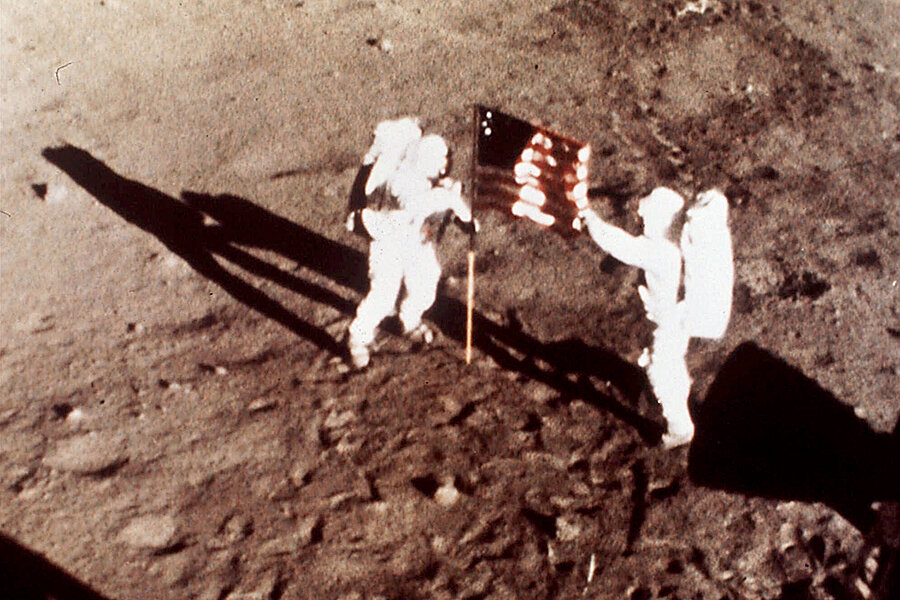Moon landing anniversary: Will US ever go back?
Loading...
Happy Moon Day! Forty-six years ago to the day, Apollo 11 astronauts landed on the lunar surface. After millenniums of watching the glowing orb wax and wane in the night sky, mankind – represented by Neil Armstrong and Buzz Aldrin – had finally landed on the moon.
As with many great achievements, the final touchdown wasn’t a smooth production. When the fragile bug of the lunar module neared the surface, commander Armstrong thought its computers were guiding toward an unsafe area. He took manual control and steered for something more suitable. When he finally jarred down on hard surface, there was only about 40 seconds of propellant left.
“We copy you on the ground,” said capsule communicator Charles Duke at ground control in Houston, after Armstrong reported touchdown. “You got a bunch of guys about to turn blue. We are breathing again. Thanks a lot.”
The schedule called for Armstrong and Aldrin to sleep at that point. But this rest period was postponed at the astronauts’ request. Six hours later, Armstrong emerged from the lunar module. He edged down the ladder, jumped onto the trash-can-sized pad of the module’s leg, and then slide-stepped onto the moon.
That’s when he delivered his famous line: “That’s one small step for [a] man, one giant leap for mankind.”
You’ll notice the brackets in that quote. That’s because Armstrong apparently dropped the “a” when actually saying those words. He’d thought he said it right, and the National Aeronautics and Space Administration said static had interfered with the transmission, but upon close examination reporters felt he’d missed it, which made the phrase contradictory, literally speaking.
In later years, Armstrong accepted that he’d screwed up, apparently. The conspiracy-debunking site Snopes.com notes that the whole thing remains a bit up in the air.
“Happily for Neil Armstrong, the tremendous scientific and cultural importance of his achievement dwarfed his minor verbal slip-up, and despite his failure to deliver his line as planned, it remains one of the world’s most famous sentences,” Snopes writes.
No kidding.
Many of those who watched the landing on grainy black-and-white television found it one of the most thrilling moments of their lives. President Nixon’s reaction was in fact typical. He watched the first step from a small room off the Oval Office, which was filling with TV gear in preparation for the broadcast of his congratulatory phone call. When he saw Armstrong reach the moon, he clapped and cheered “hooray” like a schoolboy, remembered Chief of Staff H.R. Haldeman in his diaries.
“He’s very excited by the whole thing,” Haldeman wrote.
After Armstrong and Aldrin returned to the safety of their small craft, the president talked to them from the White House. The note on the presidential schedule recording this event is matter of fact, which somehow emphasizes the importance of the event: “The President held an interplanetary conversation with Apollo 11 astronauts ....” it said.
“Because of what you have done, the heavens have become a part of man’s world, and as you talk to us from the Sea of Tranquillity, it inspires us to redouble our efforts to bring peace and tranquillity to earth,” Nixon told the space pioneers.
The next day, The New York Times editorialized that the president was trying to horn in on the astronauts' glory and that he should not have wasted their precious time on the moon. This caused much grumbling and a renewed effort to ban contact between the Times and high administration officials.
Back on the moon, the astronauts went through their planned schedule, deploying a solar wind composition experiment, collecting lunar samples, taking panoramic photos, and so forth. They spent a few hours short of a day on the moon before ascending back to the Apollo 11 command module.
When they returned to Earth, they splashed down in the Pacific Ocean. Nixon watched from a nearby aircraft carrier. He was giddy.
“P [the president] was exuberant, really cranked up, like a little kid.... Showed everyone his fancy binoculars,” Haldeman wrote in his diary.
Will the United States ever resume manned moon flights? Not anytime soon, it appears. In 2011, for budget reasons, President Obama canceled NASA’s Constellation program, which had planned a return to the lunar surface by 2020.
An aspect of Constellation, development of the planned Orion manned space capsule, continues. It made its first flight last December. NASA hopes that someday Orion will carry astronauts to the moon, or Mars. But its first manned test flight isn’t scheduled until 2021. And who knows what the budget will bring before then?
As a percent of gross domestic product, NASA’s budget peaked in the mid-1960s. In 1966, the US spent 4.4 percent of its national income on space. Today, it’s less than half of 1 percent, according to data developed by the Guardian.
And the US public isn’t exactly burning for another Neil Armstrong moment. It is about as interested in space today as it was in 1979, according to National Science Foundation figures. A 2014 NSF survey found that about 22 percent of the public is “very interested” in space exploration, with 45 percent “moderately interested” and 33 percent “not at all” interested.
“Americans have an up-or-down relationship with space travel, with sometimes wish-washy support,” writes Amber Phillips of "The Fix" blog at The Washington Post.








